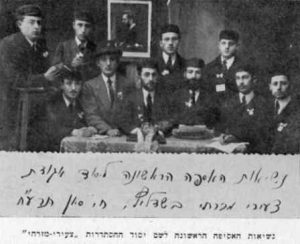After the terrible pogrom perpetrated by the Russians in 1905 against the Jews of Siedlce, many of its inhabitants left the city. Some moved to other provinces, and some left Poland for the United States, Canada, and South Africa. Among these was Mordechai Rozenbach, who established a thriving tobacco factory in Durban in South Africa, and contributed heavily to the Hebrew University of Jerusalem and Yeshivot in Eretz-Israel.
The arrival of the Siedlce Jews to Eretz-Israel began many years before the “official” Zionism of the late 19th century. From my generation’s immigrants was the treasurer of the Skerneibitz Hasidim, Rabbi Israel Yosef. He went to Eretz-Israel and came back a year later with tufts from the beginning of the shearing, and bunches of Eretz-Israel moss to distribute among acquaintances. The tufts and mosses served as a blessing on the perfumes on Saturday night. Eventually, he returned to Eretz-Israel. Like Rabbi Leibel who had a lime factory, all his life he longed to immigrate to Israel-Israel and set up a similar plant. During the British mandate he received immigration permits, sold the house to his factory in Siedlce and immigrated to Israel. He spent the rest of his life in an old-age home in Jerusalem.

Among them was also Rabbi Avraham Moshe Weinberg, son of “Orian”, a vinegar factory owner, who suffered a lot in the Eretz-Israel. A heart stroke caused his death while studying Talmud, at Gur Hasidim center in Tel Aviv.
Rabbi Didier Rainman, an Orthodox who was a banks accountant and a candidate for Rabbi’s role in Siedlce after the death of Rabbi Analik Tiktin, immigrated to Eretz-Israel and died in an accident in Tel Aviv on Iayer Tr”tz – 1930. His father, known as Rabbi Leibish Ididis, immigrated to Israel and died in Jerusalem a few years after the death of his only son.
One of Razdin Hasidim who came to Israel from Siedlce was Rabbi Kalman Hoober, a scholar of great reputation. He was weak and sickly, but upon arriving to Eretz-Israel he settled in “Ha’Mizrahi”‘s Kfar Hittin”. When visiting here I was surprised to see how good he was at working the land and that was known as one of the best farmers. When all the people of Hittin dispersed for lack of water, Rabbi Hoober settled in Petach Tikva and made a living from a grocery store for the rest of his life.
My father’s and grandfather’s home was a house of Torah and Hasidism. As his eldest son dad gave me Torah generously, more than was customary at my age. At two and a half years old I was led to the Hedder, wrapped in a prayer shawl. At five years old I began to study Bible and a dinner was held at the occasion. I had to give a Drasha – I think this is when I lost my fear of speaking in public, and at about six years old I began to study Talmud. In all my years growing up, I went with Dad every year, according to the custom of the Hasidim, to the Rabbi of Skarniebitz at Shavuot and in Rosh Hashanah until Yom Kippur. At twelve-years-old I already made up some innovations to Torah. Many innovations were printed in journals distributed in the European Communities and “Ha’Measef” in Jerusalem. Later on I wrote some chapters for the Hasidism, and these were grouped, in Eretz-Israel in the books “rumors and evidence”, “Olat Month”, and “Sayings. “
And how did I arrive to Zionism?
I was about five or six years old. My father went to the Rebbe, and I’m still too young to go out with him on his journeys. I went praying with my uncle Isaiah Zeidentzeig (Ben-Sinai), my mother’s brother, in the house of a “GUR” Hasid in Siedlce. Between “Sh’Harit” and “Moosaf” I went to my grandmother’s for a bite. And there was my uncle who was a long-time Zionist, with his friend, Leibshe Kahane, and they both began to sing the songs of Zion in Yiddish and Hebrew. The music and the words conquered my heart. I recall. I could not taste anything and listened, fascinated, to the singing. Ever since then I’ve dreamed of Zion and saw it in dreams and reverie. As soon as I heard about the establishment of “Ha’Mizrahi” in Warsaw – I organized the eastern branch in Siedlce.
Two Rabbis were the Halachic authority in Poland on behalf of the German government of Kaiser Wilhelm II: Rabbi Shlomo Carlebach and Rabbi Dr. Pinhas Cohen. Both were out to establish organizations of pious Jews to serve as a barrier against the spirit of Zionism which blew from the west and particularly from England after the Balfour Declaration. Youngsters, whom the idea appealed to their hearts, founded the “Tvuna” organization, aimed ostensibly for Jewish Studies but with anti-Zionist winds blowing clearly between the lines.
The two rabbis in Poland also managed to gather many rabbis and Hasidic leaders, establishing “the faithful of Israel”, or “Orthodox Association”, and later changed the name to “Agudath Israel”. They aimed to strengthen religious Judaism and consolidate it, positive goals in themselves, but their main purpose was anti-Zionist.

Word of “Ha’Mizrahi” in Siedlce traveled as far as Eretz-Israel. I immigrated to Israel in Trf”d with my family. I found out that the movement has expanded and evolved, the number of members has reached hundreds, and they founded a school and took up senior positions in the community’s establishments and the rabbinate. Unfortunately, our friends, the Jews of Siedlce, perished and were destroyed by Nazi oppressor. Hopefuly, my words will be Yad Vashem in their memory.
